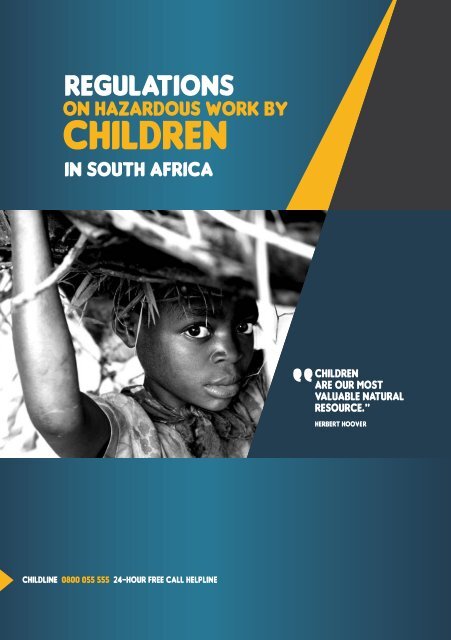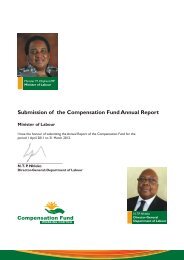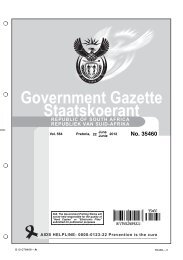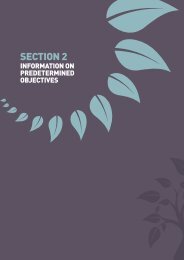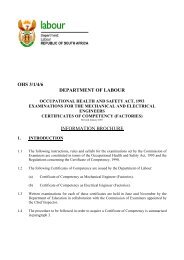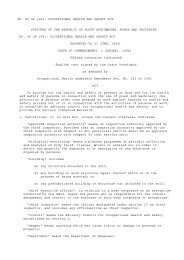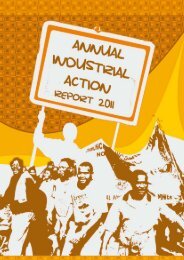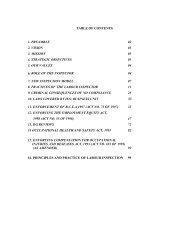Regulations on hazardous work by children in South Africa.pdf
Regulations on hazardous work by children in South Africa.pdf
Regulations on hazardous work by children in South Africa.pdf
You also want an ePaper? Increase the reach of your titles
YUMPU automatically turns print PDFs into web optimized ePapers that Google loves.
3 | <str<strong>on</strong>g>Regulati<strong>on</strong>s</str<strong>on</strong>g> On <strong>hazardous</strong> <strong>work</strong> <strong>by</strong> Children <strong>in</strong> <strong>South</strong> <strong>Africa</strong>MINIMUM AGE OF WORKA child <strong>work</strong>er who is under 15 years of age or is subject to compulsory school<strong>in</strong>g may not beemployed as a child <strong>work</strong>er and may not assist any pers<strong>on</strong> to carry <strong>on</strong> their bus<strong>in</strong>ess.However, a child <strong>work</strong>er who is under 15 years if age or subject to compulsory school<strong>in</strong>g may:• Work <strong>in</strong> the performance of advertis<strong>in</strong>g, artistic or cultural activities <strong>in</strong> terms of a permitgranted <strong>in</strong> terms of Sectoral Determ<strong>in</strong>ati<strong>on</strong> 10: Children <strong>in</strong> the Performance ofAdvertis<strong>in</strong>g, Artistic and Cultural Activities issued <strong>by</strong> the M<strong>in</strong>ister of Labour <strong>in</strong> terms ofthe BCEA (employers <strong>in</strong> these sectors should study the sectoral determ<strong>in</strong>ati<strong>on</strong> which canbe accessed <strong>on</strong> www.labour.gov.za)• Do the follow<strong>in</strong>g <strong>work</strong>, other than as an employee as def<strong>in</strong>ed <strong>in</strong> the BCEA:- Collect c<strong>on</strong>tributi<strong>on</strong>s <strong>on</strong> behalf of a fund-rais<strong>in</strong>g organisati<strong>on</strong> registered<strong>in</strong> terms of the Fund Rais<strong>in</strong>g Act, (Act No. 107 of 1978)- Do voluntary <strong>work</strong> for a church, charitable organisati<strong>on</strong> or amateur sports club- As part of his/her school<strong>in</strong>g, do <strong>work</strong> that is appropriate for a pers<strong>on</strong> of that ageor which does not place at risk the child’s well-be<strong>in</strong>g, educati<strong>on</strong>, physical or mentalhealth, or spiritual, moral or social development.• Even though the child <strong>work</strong>er may perform types of <strong>work</strong> referred to above, such <strong>work</strong> is stillsubject to the provisi<strong>on</strong>s of the regulati<strong>on</strong>s summarised here.• In terms of the <strong>South</strong> <strong>Africa</strong>n Schools Act a child <strong>work</strong>er is subject to compulsory school<strong>in</strong>g untilthe last school day of the calendar year <strong>in</strong> which such learner reaches the age of 15 yearsor the n<strong>in</strong>th grade, whichever occurs first.ACCESS TO NUTRITION, HEALTH CARE AND EDUCATIONAL SERVICESAn employer who employs a child <strong>work</strong>er must ensure that their employment does not <strong>in</strong>terfere with:• Their access to adequate nutriti<strong>on</strong>• Their access to adequate primary health care services• The educati<strong>on</strong> of a child <strong>work</strong>er who is enrolled at a school or at any other educati<strong>on</strong>al <strong>in</strong>stituti<strong>on</strong>.
4 | <str<strong>on</strong>g>Regulati<strong>on</strong>s</str<strong>on</strong>g> On <strong>hazardous</strong> <strong>work</strong> <strong>by</strong> Children <strong>in</strong> <strong>South</strong> <strong>Africa</strong>WORK AWAY FROM PARENTS OR LEGAL GUARDIANA child <strong>work</strong>er may <strong>on</strong>ly perform <strong>work</strong> which will result <strong>in</strong> its be<strong>in</strong>g away overnight from its parents or legal guardian:• If the child’s parent or legal guardian c<strong>on</strong>sents <strong>in</strong> writ<strong>in</strong>g• If the child is enrolled <strong>in</strong> school, the school<strong>in</strong>g of a school go<strong>in</strong>g child is not adversely affected.In additi<strong>on</strong>, the employer must provide:• Full details of the accommodati<strong>on</strong> arrangements to the parent or legal guardian of thechild <strong>work</strong>er for their approval• Free of charge to the child, accommodati<strong>on</strong> that:- Is clean, comfortable, suitable and safe for the child- Is not occupied <strong>by</strong> any adult other than the parent, legal guardian or a child<strong>work</strong>er m<strong>in</strong>der appo<strong>in</strong>ted or designated <strong>by</strong> the parent of the child, if theyaccompany the child- Sufficient bedd<strong>in</strong>g, lavatory and wash<strong>in</strong>g facilities for the child <strong>work</strong>er• The child <strong>work</strong>er with nutritious food or, if the child is able to purchase such food with<strong>in</strong> areas<strong>on</strong>able distance from the place of <strong>work</strong> or accommodati<strong>on</strong>, provide the child with anallowance sufficient to purchase food and enable the child to purchase it at appropriate <strong>in</strong>tervals.It is an offence for any pers<strong>on</strong> to recruit a child <strong>work</strong>er to perform <strong>work</strong> <strong>in</strong> violati<strong>on</strong> of this regulati<strong>on</strong>.PROHIBITION OF PIECEWORK AND TASK WORKNo pers<strong>on</strong> may require or permit a child <strong>work</strong>er to perform piece<strong>work</strong> or task <strong>work</strong>. Piece<strong>work</strong> is <strong>work</strong> <strong>in</strong> terms of whichremunerati<strong>on</strong> is based ma<strong>in</strong>ly <strong>on</strong> the quantity of <strong>work</strong> d<strong>on</strong>e. Task <strong>work</strong> is <strong>work</strong> <strong>in</strong> terms of which the remunerati<strong>on</strong> of a <strong>work</strong>eris based ma<strong>in</strong>ly <strong>on</strong> the completi<strong>on</strong> of set tasks.This does not prevent a child <strong>work</strong>er be<strong>in</strong>g paid a commissi<strong>on</strong> or receiv<strong>in</strong>g an <strong>in</strong>centive payment <strong>on</strong> the completi<strong>on</strong> of a task if:• The child is paid at least the m<strong>in</strong>imum wage prescribed for that <strong>work</strong> <strong>in</strong> terms of anysectoral determ<strong>in</strong>ati<strong>on</strong> or barga<strong>in</strong><strong>in</strong>g council agreement• In the absence of any such m<strong>in</strong>imum wage, the child, <strong>in</strong> additi<strong>on</strong> to any commissi<strong>on</strong> or<strong>in</strong>centive payment received, is paid a basic wage, calculated <strong>on</strong> the basis of time <strong>work</strong>ed,and this wage is more than the commissi<strong>on</strong> or <strong>in</strong>centive payment received, and is calculated<strong>on</strong> a c<strong>on</strong>sistent basis.MAXIMUM DAILY AND WEEKLY WORKING TIME• A child <strong>work</strong>er may not <strong>work</strong> more than 8 hours <strong>on</strong> any day• A child <strong>work</strong>er who is not enrolled at school may not <strong>work</strong> for more than 40 hours <strong>in</strong> any week• A child <strong>work</strong>er who is enrolled <strong>in</strong> school may not <strong>work</strong> for more than:- 20 hours <strong>in</strong> any week dur<strong>in</strong>g school term- 40 hours <strong>in</strong> any week that falls entirely with<strong>in</strong> school holidays- Two hours <strong>on</strong> any school day; or four hours <strong>on</strong> any school day followed<strong>by</strong> a n<strong>on</strong>-school day (e.g. a Friday, or the last day of a school term.)
5 | <str<strong>on</strong>g>Regulati<strong>on</strong>s</str<strong>on</strong>g> On <strong>hazardous</strong> <strong>work</strong> <strong>by</strong> Children <strong>in</strong> <strong>South</strong> <strong>Africa</strong>NIGHT WORK• A child <strong>work</strong>er may not <strong>work</strong> before 06:00 or after 18:00 <strong>on</strong> any day, except where allowed• A child <strong>work</strong>er, other than <strong>on</strong>e who is expected to be at school the follow<strong>in</strong>g day, may<strong>work</strong> between 18:00 and 23:00 if:- The <strong>work</strong> is <strong>in</strong> a restaurant, c<strong>in</strong>ema, theatre or shop where there is adequate adult supervisi<strong>on</strong>- The <strong>work</strong> is ba<strong>by</strong>-sitt<strong>in</strong>g or child m<strong>in</strong>d<strong>in</strong>g.• Unless the parent or legal guardian agrees otherwise <strong>in</strong> writ<strong>in</strong>g, any pers<strong>on</strong> who requiresor permits a child <strong>work</strong>er to <strong>work</strong> after 18:00 must, at the end of the shift, provide him/herwith safe transport home, at no cost to the child, parent or care-giver.PROHIBITED WORKAn employer may not require or permit a child to <strong>work</strong> <strong>in</strong> any of the follow<strong>in</strong>g:• Deep sea fish<strong>in</strong>g• Commercial div<strong>in</strong>g or other <strong>hazardous</strong> <strong>work</strong> under water• Slaughter<strong>in</strong>g of animals• Meat, poultry, or seafood process<strong>in</strong>g• The manufacture or pack<strong>in</strong>g of tobacco products or any other <strong>work</strong> <strong>in</strong> which there is exposure to tobacco dust• Logg<strong>in</strong>g• Protect<strong>in</strong>g or safeguard<strong>in</strong>g any pers<strong>on</strong> or property or <strong>work</strong> <strong>in</strong>volv<strong>in</strong>g the handl<strong>in</strong>g of firearms• Ref<strong>in</strong><strong>in</strong>g petroleum products• Fill<strong>in</strong>g cars with petroleum or other chemical fuels at a fill<strong>in</strong>g stati<strong>on</strong>, or do<strong>in</strong>g <strong>work</strong> close to such activity• Brew<strong>in</strong>g, manufactur<strong>in</strong>g or sell<strong>in</strong>g any liquid which <strong>in</strong> its f<strong>in</strong>al form would c<strong>on</strong>ta<strong>in</strong> more than <strong>on</strong>e per cent of alcohol• Work <strong>in</strong> a bar, shebeen, tavern or pub or other establishment whose primary bus<strong>in</strong>ess is tosell alcoholic beverages to the general public, for c<strong>on</strong>sumpti<strong>on</strong> <strong>on</strong> the premises• The manufacture or applicati<strong>on</strong> of tar or asphalt• Work <strong>in</strong>volv<strong>in</strong>g an exposure, or potential exposure, to blood-borne or air-borne pathogens• Work <strong>in</strong> a health care or related facility, <strong>in</strong> circumstances where there is likely exposure tobiological agents, <strong>in</strong>clud<strong>in</strong>g but not limited to Hepatitis, HIV, and tuberculosis,anaesthetics, anti-neoplastic medicati<strong>on</strong>s or addictive drugs• Work <strong>in</strong>volv<strong>in</strong>g exposure to a <strong>hazardous</strong> substance, to lead, asbestos, silica, coal or other<strong>hazardous</strong> dusts or to pressurised gases• The producti<strong>on</strong>, transport, handl<strong>in</strong>g, storage, use of, or other <strong>work</strong> <strong>in</strong>volv<strong>in</strong>g exposureto explosives or flammable substances• Work <strong>in</strong> a cas<strong>in</strong>o or other gambl<strong>in</strong>g establishment• Electrical <strong>work</strong> <strong>in</strong>volv<strong>in</strong>g high voltage cables or other power sources <strong>in</strong> excess of 250 volts• Weld<strong>in</strong>g. braz<strong>in</strong>g or solder<strong>in</strong>g• Rock and st<strong>on</strong>e crush<strong>in</strong>g• Operat<strong>in</strong>g vibrat<strong>in</strong>g equipment such as rock drills and riveters• Operat<strong>in</strong>g tractors, w<strong>in</strong>ches, forklift vehicles, fr<strong>on</strong>t-end loaders, earth mov<strong>in</strong>g equipmentor similar heavy equipment• Driv<strong>in</strong>g any motor vehicle or mobile plant• Work <strong>in</strong> vehicles transport<strong>in</strong>g passengers or heavy goods• Work <strong>in</strong> a c<strong>on</strong>f<strong>in</strong>ed space.
6 | <str<strong>on</strong>g>Regulati<strong>on</strong>s</str<strong>on</strong>g> On <strong>hazardous</strong> <strong>work</strong> <strong>by</strong> Children <strong>in</strong> <strong>South</strong> <strong>Africa</strong>WORST FORMS OF CHILD LABOURIn additi<strong>on</strong>, no pers<strong>on</strong> may require or permit a child to <strong>work</strong> <strong>in</strong> any of the follow<strong>in</strong>g:• Underground m<strong>in</strong><strong>in</strong>g• Work <strong>in</strong> c<strong>on</strong>necti<strong>on</strong> with the operati<strong>on</strong> of a smelter or furnace, or roll<strong>in</strong>g mills thatform and cut metals• The producti<strong>on</strong> of alum<strong>in</strong>ium, brass, br<strong>on</strong>ze or similar alloys, charcoal or the fuel, coke• The manufacture of auram<strong>in</strong>e, isopropanol or magenta• The gasificati<strong>on</strong> of coal• Div<strong>in</strong>g operati<strong>on</strong>s us<strong>in</strong>g aqualungs• Free div<strong>in</strong>g below depths of 10 metres• Work <strong>in</strong> which there is a reas<strong>on</strong>ably foreseeable risk of exposure toblood-borne and airborne pathogens• Work <strong>in</strong>volv<strong>in</strong>g exposure to i<strong>on</strong>is<strong>in</strong>g radiati<strong>on</strong>• Work <strong>in</strong> chemically-based m<strong>in</strong>eral extracti<strong>on</strong> or similar operati<strong>on</strong>s• Any <strong>work</strong> <strong>in</strong> an envir<strong>on</strong>ment <strong>in</strong> which the actual dry-bulb temperature is below m<strong>in</strong>us 18 °C• Hard manual labour for a period of l<strong>on</strong>ger than 15 m<strong>in</strong>utes <strong>in</strong> any hour <strong>in</strong> an envir<strong>on</strong>ment <strong>in</strong>which the time-weighted average WBGT <strong>in</strong>dex, (as def<strong>in</strong>ed <strong>in</strong> the Envir<strong>on</strong>mental <str<strong>on</strong>g>Regulati<strong>on</strong>s</str<strong>on</strong>g>for Workplaces, made <strong>in</strong> terms of the Occupati<strong>on</strong>al Health and Safety Act, 1993,)determ<strong>in</strong>ed over a period of <strong>on</strong>e hour, is greater than 36• Work <strong>in</strong> circumstances <strong>in</strong> which it is reas<strong>on</strong>ably foreseeable that the child will beexposed to physical, psychological or sexual abuse.Any form of <strong>work</strong> listed above c<strong>on</strong>stitutes a worst form of child labour as c<strong>on</strong>templated <strong>in</strong> the Worst Forms of Child LabourC<strong>on</strong>venti<strong>on</strong>, 1999, adopted <strong>by</strong> the Internati<strong>on</strong>al Labour Organisati<strong>on</strong>. These prohibiti<strong>on</strong>s may overlap to some extent with theprohibiti<strong>on</strong>s listed, but the activities referred to are c<strong>on</strong>sidered as expos<strong>in</strong>g <strong>children</strong> to very serious harm. Penalties for breachshould therefore be higher.NO PERSON MAY:• Employ a child <strong>in</strong> circumstances <strong>in</strong> which the child is unreas<strong>on</strong>ably c<strong>on</strong>f<strong>in</strong>ed tothe employer’s premises• Require or permit a child to engage for that pers<strong>on</strong>’s benefit <strong>in</strong> <strong>on</strong>e of follow<strong>in</strong>gactivities when this <strong>work</strong> is performed <strong>by</strong> a child as part of an organised bus<strong>in</strong>essactivity c<strong>on</strong>ducted <strong>by</strong> that pers<strong>on</strong>:- Begg<strong>in</strong>g- Scaveng<strong>in</strong>g or collect<strong>in</strong>g waste from garbage or waste dumps- Use, recruit, procure or offer a child for the commissi<strong>on</strong> of any serious offence(they are listed <strong>in</strong> schedules 1 and 2 of the Crim<strong>in</strong>al Procedure Act, 1977).The BCEA regulati<strong>on</strong>s def<strong>in</strong>e which specific substances agents are c<strong>on</strong>sidered very harmful to <strong>children</strong>.
7 | <str<strong>on</strong>g>Regulati<strong>on</strong>s</str<strong>on</strong>g> On <strong>hazardous</strong> <strong>work</strong> <strong>by</strong> Children <strong>in</strong> <strong>South</strong> <strong>Africa</strong>RISK ASSESSMENTEvery employer who employs or provides <strong>work</strong> to a child <strong>work</strong>er, or permits any child <strong>work</strong>er to <strong>work</strong> at any place under theirc<strong>on</strong>trol, or with any mach<strong>in</strong>ery under their c<strong>on</strong>trol, must <strong>in</strong> respect of such <strong>work</strong> undertake a risk assessment process whichmust at least <strong>in</strong>clude the follow<strong>in</strong>g:• Identify<strong>in</strong>g the risks and hazards to which any child <strong>work</strong>er may be exposed• Analys<strong>in</strong>g and evaluat<strong>in</strong>g the risks and hazards that are identified• Prepar<strong>in</strong>g and implement<strong>in</strong>g:- A documented plan of safe <strong>work</strong> procedures to remove, mitigate, reduce orc<strong>on</strong>trol the risks and hazards that have been identified- A m<strong>on</strong>itor<strong>in</strong>g plan- A review plan.The follow<strong>in</strong>g factors must be taken <strong>in</strong> to account when mak<strong>in</strong>g the risk assessment:• The <strong>in</strong>creased biological sensitivity of <strong>children</strong> to chemicals, biological agents, carc<strong>in</strong>ogensand horm<strong>on</strong>e disruptors• The <strong>in</strong>creased vulnerability of <strong>children</strong> to sleep disrupti<strong>on</strong>• The vulnerability of <strong>children</strong> to direct and <strong>in</strong>direct coerci<strong>on</strong> or abuse from any pers<strong>on</strong>,particularly when <strong>work</strong><strong>in</strong>g al<strong>on</strong>e• The relative lack of experience and maturity of <strong>children</strong> <strong>in</strong> mak<strong>in</strong>g safety judgments• The reduced ability of <strong>children</strong> to adapt to <strong>in</strong>flexible <strong>work</strong> rout<strong>in</strong>es• The reduced ability of <strong>children</strong> to perceive dangers correctly• The reduced capacity of <strong>children</strong> to understand safety messages• Whether the design of any mach<strong>in</strong>ery, tools, equipment and protective equipmentis appropriate for <strong>children</strong>’s stature• The implicati<strong>on</strong>s of <strong>children</strong> <strong>work</strong><strong>in</strong>g at the period when their skeletal structuresand b<strong>on</strong>es are still develop<strong>in</strong>g• Children’s physical development <strong>in</strong> relati<strong>on</strong> to erg<strong>on</strong>omics, <strong>in</strong> order to ensure a healthyand safe <strong>work</strong><strong>in</strong>g envir<strong>on</strong>ment• The physiological, horm<strong>on</strong>al and other vulnerabilities of <strong>children</strong> at puberty.In the risk assessment process, the employer must have regard to the guidel<strong>in</strong>es c<strong>on</strong>ta<strong>in</strong>ed <strong>in</strong>Schedule 1 to the Health and Safety of Children at Work <str<strong>on</strong>g>Regulati<strong>on</strong>s</str<strong>on</strong>g> issued <strong>in</strong> terms of the OHSA.
8 | <str<strong>on</strong>g>Regulati<strong>on</strong>s</str<strong>on</strong>g> On <strong>hazardous</strong> <strong>work</strong> <strong>by</strong> Children <strong>in</strong> <strong>South</strong> <strong>Africa</strong>RESPIRATORY HAZARDSA child <strong>work</strong>er may not undertake any <strong>work</strong> where a pers<strong>on</strong> over the age of 17 perform<strong>in</strong>g the same <strong>work</strong> would be required<strong>in</strong> terms of the OHSA to wear respiratory protecti<strong>on</strong> equipment, i.e. equipment such as masks that protects <strong>work</strong>ers from<strong>in</strong>hal<strong>in</strong>g <strong>hazardous</strong> dusts or fumes.WORK IN AN ELEVATED POSITION• A child <strong>work</strong>er may not <strong>work</strong> at a height of more than 5 metres above the floor/ground• A child <strong>work</strong>er <strong>work</strong><strong>in</strong>g at a height of more than 2 metres from the floor/ground must <strong>work</strong>under the supervisi<strong>on</strong> of the employer or a competent adult employee, and reas<strong>on</strong>able fallprotecti<strong>on</strong> must be provided, such as a safety harness or rail<strong>in</strong>gs.LIFTING OF HEAVY WEIGHTSA child <strong>work</strong>er perform<strong>in</strong>g any <strong>work</strong> may not, as part of their <strong>work</strong>, lift an object weigh<strong>in</strong>g more than:• The lesser of 15 kg or 20 % of the child’s body weight• More than 7,5 kg more than <strong>on</strong>ce per m<strong>in</strong>ute.A child <strong>work</strong>er may not lift objects weigh<strong>in</strong>g more than 5 kg at <strong>work</strong> for more than 2 hours without be<strong>in</strong>g granted a 30-m<strong>in</strong>uteperiod <strong>in</strong> which he or she is not required to lift such a weight.WORK IN A COLD ENVIRONMENTThe employer of a child <strong>work</strong>er <strong>work</strong><strong>in</strong>g <strong>in</strong> an envir<strong>on</strong>ment below the follow<strong>in</strong>g actual dry-bulbtemperature must be supplied with suitable protective warm cloth<strong>in</strong>g:• 0°C where the <strong>work</strong> <strong>in</strong>volves repeated entry <strong>in</strong>to, or presence for more thantwo m<strong>in</strong>utes <strong>in</strong> such envir<strong>on</strong>ment• 6°C where the <strong>work</strong> <strong>in</strong>volves repeated entry <strong>in</strong>to, or presence for more than<strong>on</strong>e hour <strong>in</strong> such envir<strong>on</strong>ment.The protective warm cloth<strong>in</strong>g supplied to a child <strong>work</strong>er must comply with Regulati<strong>on</strong> 2(2)(b)(i) to (vi) of the Envir<strong>on</strong>mental<str<strong>on</strong>g>Regulati<strong>on</strong>s</str<strong>on</strong>g> for Workplaces.
9 | <str<strong>on</strong>g>Regulati<strong>on</strong>s</str<strong>on</strong>g> On <strong>hazardous</strong> <strong>work</strong> <strong>by</strong> Children <strong>in</strong> <strong>South</strong> <strong>Africa</strong>WORK IN A HOT ENVIRONMENTNo pers<strong>on</strong> may require or permit a child <strong>work</strong>er to <strong>work</strong> or perform hard manual labour where the averagetemperature over <strong>on</strong>e hour exceeds 30˚C unless the child:• Is acclimatised to such <strong>work</strong><strong>in</strong>g envir<strong>on</strong>ment before he/she is required or permittedto <strong>work</strong> <strong>in</strong> such an envir<strong>on</strong>ment• Has dr<strong>in</strong>k breaks every 15 m<strong>in</strong>utes• Is cognisant of the need to dr<strong>in</strong>k at least 150ml of liquid every break, and theemployer provides the child with the necessary liquids.The term ‘average temperature’ referred to here is technically the time-weighted average WBGT <strong>in</strong>dex as def<strong>in</strong>ed<strong>in</strong> the Envir<strong>on</strong>mental <str<strong>on</strong>g>Regulati<strong>on</strong>s</str<strong>on</strong>g> for Workplaces, made <strong>in</strong> terms of the Occupati<strong>on</strong>al Health and Safety Act, 1993,and determ<strong>in</strong>ed over a period of <strong>on</strong>e hour.WORK IN NOISY ENVIRONMENTNo pers<strong>on</strong> may require or permit a child <strong>work</strong>er to perform any <strong>work</strong> <strong>in</strong>volv<strong>in</strong>g an exposure to a noise level <strong>in</strong> excessof 80 dB(A) unless the child is supplied with hear<strong>in</strong>g protective equipment that complies with regulati<strong>on</strong> 12 of the Noise-Induced Hear<strong>in</strong>g Loss <str<strong>on</strong>g>Regulati<strong>on</strong>s</str<strong>on</strong>g>, made <strong>in</strong> terms of the Occupati<strong>on</strong>al Health and Safety Act, 1993. DB(A) is a unit used <strong>in</strong>measur<strong>in</strong>g noise, and takes <strong>in</strong>to account how often loud noises are heard, even if an envir<strong>on</strong>ment is not noisy all the time.POWER TOOLS AND CUTTING OR GRINDING EQUIPMENT• A child <strong>work</strong>er may not use any power-driven mach<strong>in</strong>ery or power tool, or any cutt<strong>in</strong>g or gr<strong>in</strong>d<strong>in</strong>g equipmentunless a risk assessment c<strong>on</strong>ducted <strong>in</strong> terms of the regulati<strong>on</strong>s has determ<strong>in</strong>ed that its use is safe and withoutsignificant risks for the child• If the risk assessment <strong>in</strong>dicates that the power tool or other equipment is safe and without significant risksfor the child <strong>work</strong>er to use, if used with safety equipment or facilities, the child:- Must be provided with the necessary safety equipment and facilities that areusually required <strong>in</strong> terms of occupati<strong>on</strong>al health and safety regulati<strong>on</strong>s- Must be <strong>in</strong>structed <strong>in</strong> the use, ma<strong>in</strong>tenance and limitati<strong>on</strong>s of such equipment• Before start<strong>in</strong>g such <strong>work</strong> the child <strong>work</strong>er must receive adequate tra<strong>in</strong><strong>in</strong>g <strong>in</strong> the safe and appropriateuse of the power tools or mach<strong>in</strong>ery from a pers<strong>on</strong> competent <strong>in</strong> their use• The child <strong>work</strong>er must be supervised <strong>by</strong> a competent pers<strong>on</strong> when us<strong>in</strong>g power tools or other equipment• An <strong>in</strong>spector may issue a notice prohibit<strong>in</strong>g the use <strong>by</strong> child <strong>work</strong>ers of any power tool or other mach<strong>in</strong>ery.REPORT TO DEPARTMENT OF SOCIAL DEVELOPMENTA Labour Inspector who f<strong>in</strong>ds a child <strong>work</strong>er be<strong>in</strong>g employed or used <strong>in</strong> c<strong>on</strong>traventi<strong>on</strong> of the Act or of these regulati<strong>on</strong>sshall refer the matter for <strong>in</strong>vestigati<strong>on</strong> to a child protecti<strong>on</strong> organisati<strong>on</strong> designated <strong>in</strong> terms of the Children’s Act, No 38of 2005 or to the Prov<strong>in</strong>cial Department of Social Development <strong>in</strong> the prov<strong>in</strong>ce where the child <strong>work</strong>s or lives, unless thelabour <strong>in</strong>spector is satisfied that the child will not suffer any detriment due to steps be<strong>in</strong>g taken <strong>by</strong> the <strong>in</strong>spector to ensurecompliance with the law.The relevant social <strong>work</strong>er must then <strong>in</strong>vestigate the circumstances of the child <strong>work</strong>er to determ<strong>in</strong>e whether he/she is <strong>in</strong>need of care and protecti<strong>on</strong> and, if so, take appropriate acti<strong>on</strong> to protect the child.
10 | <str<strong>on</strong>g>Regulati<strong>on</strong>s</str<strong>on</strong>g> On <strong>hazardous</strong> <strong>work</strong> <strong>by</strong> Children <strong>in</strong> <strong>South</strong> <strong>Africa</strong>Hazardous substances and agentsHazardous substances and agents referred to <strong>in</strong> regulati<strong>on</strong> 8(0):4-Am<strong>in</strong>obiphenylArsenic and arsenic compoundsAsbestosBenzeneBenzid<strong>in</strong>eBeryllium and beryllium compoundsN,N-Bis(2-chloroethyl)-2-naphthylam<strong>in</strong>e (Chlornaphaz<strong>in</strong>e)Bis(chloromethyl)ether and chloromethyl methyl ether1,4-Butanediol dimethanesulf<strong>on</strong>ate (Busulphan; Myleran)Cadmium and cadmium compounds1-(2-Chloroethyl)-3-(4-methylcyclohexyl)-1-nitrosourea (Methyl-CCNU; Semust<strong>in</strong>e)Chromium [VI] compoundsCoal-tarsCyanideEri<strong>on</strong>iteEthylene oxideFormaldehydeGallium arsenideLeadMercuryM<strong>in</strong>eral oils, untreated and mildly treatedMustard gas (Sulfur mustard)2-Naphthylam<strong>in</strong>eNickel compoundsPhosphorus-32, as phosphatePlut<strong>on</strong>ium-239 and its decay products, as aerosolsRadioiod<strong>in</strong>es, short-lived isotopes, <strong>in</strong>clud<strong>in</strong>g iod<strong>in</strong>e-131Radi<strong>on</strong>uclides, a-particle-emitt<strong>in</strong>g, <strong>in</strong>ternally depositedRadi<strong>on</strong>uclides, b-particle-emitt<strong>in</strong>g, <strong>in</strong>ternally depositedRadium-224, -226, -228, and their decay productsRad<strong>on</strong>-222 and its decay productsShale-oilsSilica, crystall<strong>in</strong>eSootsSulfuric acid, str<strong>on</strong>g-<strong>in</strong>organic-acid mists c<strong>on</strong>ta<strong>in</strong><strong>in</strong>gTalc c<strong>on</strong>ta<strong>in</strong><strong>in</strong>g asbestiform fibres2,3,7,8-Tetrachlorodibenzo-para-diox<strong>in</strong>ThiotepaTreosulfanV<strong>in</strong>yl chloride
11 | <str<strong>on</strong>g>Regulati<strong>on</strong>s</str<strong>on</strong>g> On <strong>hazardous</strong> <strong>work</strong> <strong>by</strong> Children <strong>in</strong> <strong>South</strong> <strong>Africa</strong>Labour Head Office - Tel: (012) 309 4000 | Fax: (012) 320 2059 | Email: webmaster@labour.gov.zaProv<strong>in</strong>cial Offices of the Department of LabourEastern Cape - East L<strong>on</strong>d<strong>on</strong> Tel: (043) 701 3128Free State - Bloemf<strong>on</strong>te<strong>in</strong> Tel: (051) 505 6200Gauteng Prov<strong>in</strong>cial Office Tel: (011) 853 0300KwaZulu-Natal - Durban Tel: (031) 366 2000Limpopo - Polokwane Tel: (015) 290 1744Labour Centres of the Department of LabourEASTERN CAPEAliwal North Tel: (051) 633 2633Butterworth Tel: (047) 491 0656Cradock Tel: (048) 881 3010East L<strong>on</strong>d<strong>on</strong> Tel: (043) 702 7500Fort Beaufort Tel: (046) 645 4686Graaff-Re<strong>in</strong>et Tel: (049) 892 2142Grahamstown Tel: (046) 622 2104K<strong>in</strong>g William’s Town Tel: (043) 643 4756Lusikisiki Tel: (039) 253 1996Maclear Tel: (045) 932 1424Mdantsane Tel: (043) 761 3151Mount Ayliff Tel: (039) 254 0282Mthatha Tel: (047) 501 5620Port Elizabeth Tel: (041) 506 5000Queenstown Tel: (045) 807 5400Uitenhage Tel: (041) 992 4627NORTHERN CAPECalv<strong>in</strong>ia Tel: (027) 341 1280De Aar Tel: (053) 631 0455Kimberley Tel: (053) 838 1500Kuruman Tel: (053) 712 3870Postmasburg Tel: (053) 313 0641Spr<strong>in</strong>gbok Tel: (027) 718 1058/9Up<strong>in</strong>gt<strong>on</strong> Tel: (054) 331 1098Mpumalanga - Witbank Tel: (013) 655 8700North West - Mmabatho Tel: (018) 387 8100Northern Cape - Kimberley Tel: (053) 838 1500Western Cape - Cape Town Tel: (021) 441 8000GAUTENGAlbert<strong>on</strong> Tel: (011) 861 6130Atteridgeville Tel: (012) 373 4432Ben<strong>on</strong>i Tel: (011) 747 9601Boksburg Tel: (011) 898 3340Brakpan Tel: (011) 744 9000Br<strong>on</strong>khorstspruit Tel: (013) 932 0197Carlet<strong>on</strong>ville Tel: (018) 788 3281Garankuwa Tel: (012) 702 4525Germist<strong>on</strong> Tel: (011) 345 6300Johannesburg Tel: (011) 223 1013Kempt<strong>on</strong> Park Tel: (011) 975 9301Krugersdorp Tel: (011) 955 4420Mamelodi Tel: (012) 812 9502Nigel Tel: (011) 814 7095Pretoria Tel: (012) 309 5063Randburg Tel: (011) 781 8144Randf<strong>on</strong>te<strong>in</strong> Tel: (011) 693 3618Roodepoort Tel: (011) 766 2000Sandt<strong>on</strong> Tel: (011) 444 7631Sebokeng Tel: (016) 592 3825Soshanguve Tel: (012) 799 6057Soweto Tel: (011) 983 8700Spr<strong>in</strong>gs Tel: (011) 365 3700Temba Tel: (071) 356 4431Vanderbijlpark Tel: (016) 981 0280Vereenig<strong>in</strong>g Tel: (016) 430 0000There is no trust more sacred than the <strong>on</strong>e the world holds with <strong>children</strong>.There is no duty more important than ensur<strong>in</strong>g that their rights arerespected, that their welfare is protected, that their lives are free from fearand want and that they can grow up <strong>in</strong> peace.” - Kofi Annan
MPUMALANGABarbert<strong>on</strong> Tel: (013) 712 3066Bethal Tel: (017) 647 2383Carol<strong>in</strong>a Tel: (017) 843 1077Emalahleni (Witbank) Tel: (013) 653 3800Eerstehoek Tel: (017) 883 2414Ermelo Tel: (017) 819 7632Groblersdal Tel: (013) 262 3150Malelane Tel: (013) 790 1528KwaMhlanga Tel: (013) 947 3173Mashish<strong>in</strong>g (Lydenburg) Tel: (013) 235 2368Mbombela (Nelspruit) Tel: (013) 753 2844Middelburg Tel: (013) 283 3600Piet Retief Tel: (017) 826 1883Sabie Tel: (013) 764 2105Secunda Tel: (017) 631 2585Standert<strong>on</strong> Tel: (017) 712 1351FREE STATEBethlehem Tel: (058) 303 5293Bloemf<strong>on</strong>te<strong>in</strong> Tel: (051) 411 6400Botshabelo Tel: (051) 534 3789Ficksburg Tel: (051) 933 2299Harrismith Tel: (058) 623 2977Kro<strong>on</strong>stad Tel: (056) 215 1812Petrusburg Tel: (053) 574 0932Phuthaditjhaba Tel: (058) 713 0373Sasolburg Tel: (016) 970 3200Welkom Tel: (057) 391 0200Zastr<strong>on</strong> Tel: (051) 673 1471KWAZULU-NATALDundee Tel: (034) 212 3147Durban Tel: (031) 336 1500Estcourt Tel: (036) 342 9361Kokstad Tel: (039) 727 2140Ladysmith Tel: (036) 638 1900Newcastle Tel: (034) 312 6038Pietermaritzburg Tel: (033) 341 5300P<strong>in</strong>etown Tel: (031) 701 7740Port Shepst<strong>on</strong>e Tel: (039) 682 2406Prospect<strong>on</strong> Tel: (031) 913 9700Richards Bay Tel: (035) 780 8700Richm<strong>on</strong>d Tel: (033) 212 2768Stanger Tel: (032) 551 4291Ulundi Tel: (035) 879 8800Verulam Tel: (032) 541 5600Vryheid Tel: (034) 980 8992LIMPOPOGiyani Tel: (015) 812 9041Jane Furse Tel: (013) 265 7210Lebowakgomo Tel: (015) 633 9360Lephalale Tel: (014) 763 2162Makhado Tel: (015) 516 0207Modimolle Tel: (014) 717 1046Mokopane Tel: (015) 491 5973Phalaborwa Tel: (015) 781 5114Polokwane Tel: (015) 299 5000Seshego Tel: (015) 223 7020Thohoyandou Tel: (015) 960 1300Tzaneen Tel: (015) 306 2600NORTH WESTBrits Tel: (012) 252 3068Christiana Tel: (053) 441 2120Klerksdorp Tel: (018) 464 8700Lichtenburg Tel: (018) 632 4323Mafikeng Tel: (018) 381 1010Mogwase Tel: (014) 555 5693Potchefstroom Tel: (018) 297 5100Rustenburg Tel: (014) 592 8214Taung Tel: (053) 994 1679Vryburg Tel: (053) 927 5221WESTERN CAPEBeaufort West Tel: (023) 414 3427Bellville Tel: (021) 941 7000Cape Town Tel: (021) 468 5500George Tel: (044) 801 1200Knysna Tel: (044) 302 6800Mitchell’s Pla<strong>in</strong> Tel: (021) 391 0591Mossel Bay Tel: (044) 691 1140Oudtshoorn Tel: (044) 203 6100Paarl Tel: (021) 872 2020Somerset West Tel: (021) 852 2535Vredenburg Tel: (022) 715 1627Worcester Tel: (023) 347 0152(English) Layout and design <strong>by</strong> the Design Studio (N<strong>on</strong>tembiso Kgatle)Directorate of Communicati<strong>on</strong>, Department of Labour.Website: www.labour.gov.za


